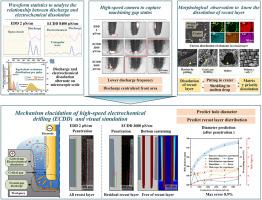High-speed electrochemical discharge drilling (ECDD) offers substantial benefits for efficient, high-quality fabrication of film cooling holes. One shortfall of this technique is the lack of a visual model for simulations. The determination of optimal machining parameters predominantly depends on trial-and-error methodologies. In order to develop a visual model for simulations, an in-depth analysis of the machining mechanism is necessary. This entails direct observation of the machining phenomena and a thorough understanding of the surface topography evolution processes. The study focuses on machining Ni-based single-crystal materials that are used in turbine blades, employing experiments to investigate the material removal mechanism. Based on the relevant conclusions, a visualized simulation model is developed for the first time. The results show that discharge and electrochemical dissolution occur alternately at the microscopic level. Besides, the discharge in low conductivity solutions is similar to pure electrical discharge drilling (EDD) rather than a gas film discharge. Discrepancies in the elemental distribution of the matrix and recast layer cause changes in the electrochemical dissolution behavior. The current efficiency of the recast layer is significantly lower than that of the matrix. Based on the mechanistic exploration, this study integrates discrete discharge with continuous electrochemical dissolution to construct a visual model of high-speed ECDD, by leveraging a dead grid method and explicit differential. This model can precisely anticipate the distribution of the recast layer and the diameter of the hole, thereby contributing valuable insights towards achieving zero recast layer machining and enhancing the use of ECDD in the aerospace industry.



